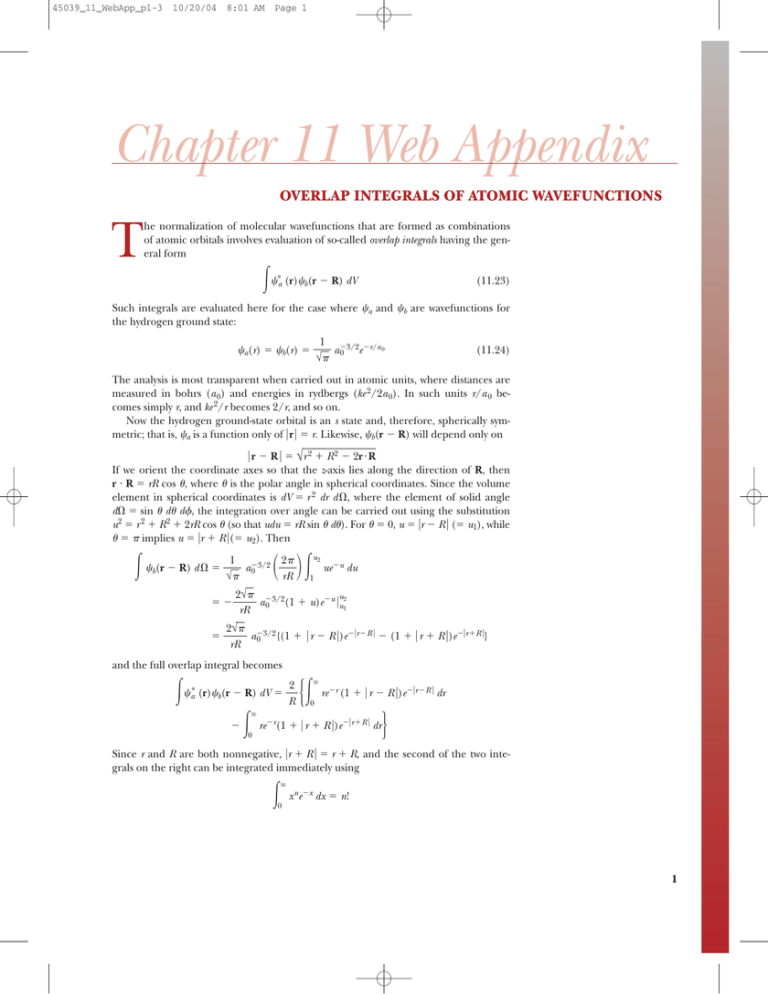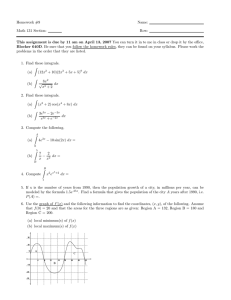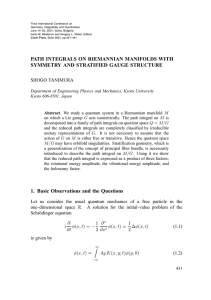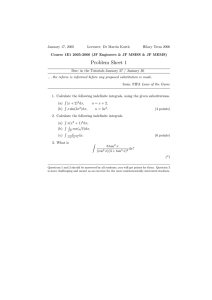T
advertisement

45039_11_WebApp_p1-3
10/20/04
8:01 AM
Page 1
Chapter 11 Web Appendix
OVERLAP INTEGRALS OF ATOMIC WAVEFUNCTIONS
T
he normalization of molecular wavefunctions that are formed as combinations
of atomic orbitals involves evaluation of so-called overlap integrals having the general form
*a (r)b(r R) dV
(11.23)
Such integrals are evaluated here for the case where a and b are wavefunctions for
the hydrogen ground state:
1 3/2 r/a 0
a
e
√
0
a(r) b(r) (11.24)
The analysis is most transparent when carried out in atomic units, where distances are
measured in bohrs (a 0) and energies in rydbergs (ke 2/2a 0). In such units r/a 0 becomes simply r, and ke 2/r becomes 2/r, and so on.
Now the hydrogen ground-state orbital is an s state and, therefore, spherically symmetric; that is, a is a function only of r r. Likewise, b(r R) will depend only on
r R √r 2 R 2 2rR
If we orient the coordinate axes so that the z-axis lies along the direction of R, then
r R rR cos , where is the polar angle in spherical coordinates. Since the volume
element in spherical coordinates is dV r 2 dr d , where the element of solid angle
d sin d d, the integration over angle can be carried out using the substitution
u2 r 2 R 2 2rR cos (so that udu rR sin d). For 0, u r R ( u1), while
implies u r R ( u2). Then
b(r R) d 1
a 3/2
√
0
2rR
u2
ue u du
1
2√
3/2
u
a
(1 u)e u u21
rR 0
2√
3/2
a0
{(1 r R )e rR (1 r R )e rR }
rR
and the full overlap integral becomes
a* (r)b(r R) dV 0
2
R
0
re r (1 r R )e rR dr
re r(1 r R )e rR dr
Since r and R are both nonnegative, r R r R, and the second of the two integrals on the right can be integrated immediately using
0
x ne x dx n!
1
45039_11_WebApp_p1-3
2
10/20/04
CHAPTER 11
8:01 AM
Page 2
WEB APPENDIX
to get
2 R
e
R
0
1 R
e
R
r (1 r R)e 2r dr 0
R1 21 e
x
2
1 2x R e
x
dx
R
The first integral must be evaluated separately in the two intervals r R and r R. For
r R, we have r R R r and we find
2 R
e
R
R
0
r (1 R r) dr [R(1 R) 2R 2/3]e R
while for r R we obtain (with x r R)
2
R
0
r (1 r R)e (2rR) dr 2 R
e
R
0
(x R)(1 x)e 2x dx
R1 23 e
R
Combining all the preceding results gives the overlap integral as
*a(r)b(r R)dV 1 R R2
3
e
R
(11.25)
With only minor alterations, the same method may be used to obtain the expressions given in the text for the energies E and E of the lowest bonding and antibonding states, respectively, of H
2.
Overlap integrals figure prominently in the calculations needed to normalize
molecular wavefunctions built up from atomic orbitals. To see how this works, consider the molecular wavefunction built from the symmetric (antisymmetric) combination of two atomic orbitals a, one centered at the origin and the other centered
at r R:
(r) a(r) a(r R)
We assume the atomic wavefunctions a are already normalized. The normalization integral for is
2 dV a(r) 2 dV a(r R) 2 dV
*a(r)a(r R) dV
a(r)*a(r R) dV
Since the atomic wavefunctions are already normalized, the first two integrals on the
right are both unity. If R is large, the last two integrals can be neglected, since the integrand for each is the product of one atomic function centered at r 0 with another
centered at r R. The resulting product is small everywhere provided R is sufficiently
large, and these integrals — the overlap integrals described previously — are very nearly
zero. Thus, in the lowest approximation
2 dV 2
and approximately normalized molecular wavefunctions can be had by multiplying by the factor 1/√2.
45039_11_WebApp_p1-3
10/20/04
8:01 AM
Page 3
OVERLAP INTEGRALS OF ATOMIC WAVEFUNCTIONS
In a more refined treatment, the overlap integrals have to be evaluated. For the hydrogen atom in the ground state, the overlap integrals are both given by Equation
11.25 above. Denoting these integrals by , we find
2 dV 2 2
and the proper normalization factor for the wavefunction becomes 1/√2(1 ).
3







